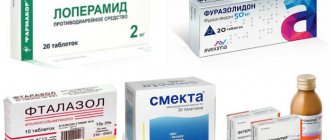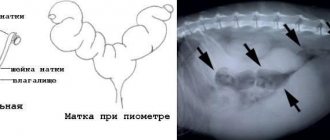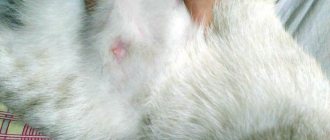Normal recovery of the dog's body
After childbirth, the uterus clears out within about a month. Rejection of the various membranes, as well as the membranes and placenta, leaves the surface bare with small blood vessels exposed. Until the mucous membrane of the organ returns to normal, the remains are rejected with blood and its own secretions. Therefore, the following discharge from the dog’s loop may be present:
- Bloody lochia with gray-green clots is acceptable in the first days. This is the remaining fluid from the amniotic sac;
- After a day they become red, the presence of blood clots is acceptable;
- Dark discharge, almost black or brown, may also be normal immediately after childbirth;
- On day 4-5, the liquid becomes brown. This indicates tissue healing;
- Subsequently, the discharge lightens and by 3-4 weeks becomes transparent, and then disappears completely;
- The peculiarity of normal lochia is the absence of an unpleasant, pungent or putrid odor.
Reference! The external genitalia of a bitch are called a loop. And lochia is discharge during the postpartum period.
In addition to the discharge, the dog also has other changes in its condition. They can mislead an inexperienced owner. The norm in the first 3-4 days after birth is:
- Slight increase in body temperature;
- Restless behavior, as during contractions. It is explained by contractions of the uterus;
- Continuous watery diarrhea.
The natural process of cleansing the uterus
The natural process of cleansing the body in females after the birth process and expelling not only all fetuses, but also the placentas of their uterus, is characterized by the appearance of lochia. These are postpartum discharges that appear as a result of the release of specific hormonal substances into the systemic circulation.
In turn, hormones provoke increased contraction of the muscle fibers of the uterus, accelerating the process of cleaning the uterine cavity from particles of the dead epithelial layer, placenta and formed clots.
Involution, or the return of the uterus to its original prenatal state, is accompanied by discharge from the loop. During childbirth and several days after the completion of the birth process, natural discharge from the vagina and vulva is characterized by a rich reddish-brown color, sometimes with a green tint.
The gray-green color of the discharge is considered normal in the first few days after birth and is caused by the escaping remains of amniotic fluid and parts of the placenta. Lochia should not have a disgusting odor. The presence of grain-like clots is acceptable and does not cause concern.
Physiologically, discharge in dogs after birth lasts 3-4 weeks. The first few days after the birth of puppies, the discharge from the female's loop may be transparent in the form of mucus interspersed with green color (green color in veterinary medicine is considered coagulated protein and does not cause concern).
Lochia can be black in color, which also refers to physiological discharge. They should not have any foreign odor, especially putrid odor. The duration of the first stage of cleansing is several days after the completion of the birth process.
If the owner notices bloody discharge, it is necessary to monitor the pet more closely. If a large amount of blood appears in the discharge, you should contact your veterinarian for help.
In order to control the color and amount of secretion released from the uterus during the process of involution, it is recommended to lay white fabric or disposable waterproof sheets in the dog’s nest. This will allow you to record all types of discharge and monitor the clinical picture.
Normally, a few days after birth, the color of the discharge changes from black-green and brown to brown. At the end of the third week, the discharge should become pale pink and mucous. At the end of the cleaning process, the lochia becomes transparent and stops.
The size of the female, the number of puppies brought and breed predisposition directly affect the amount and duration of discharge.
Discharge as a sign of complications
During the postpartum period, various situations occur when the life of a pet is at risk. By the nature of lochia, you can identify a dangerous condition and prevent a sad outcome.
Reds
Normal discharge with blood lasts up to 3-4 days. If the process is delayed or intensified, then this is a sign of uterine bleeding. Typically, lochia is bright red or pink in color. The more abundant and prolonged the discharge, the more serious the damage. The most dangerous consequence is uterine rupture.
Due to blood loss, the dog becomes lethargic and may die. Urgent veterinary attention is needed.
Black
Dark lochia for a long period is a sign of inflammation of the uterus, they have an unpleasant odor and are accompanied by elevated temperature. Black discharge lasting several days may indicate tissue necrosis, which is dangerous for the development of sepsis.
Greens
On the first day, inclusions of this shade are acceptable. But if discharge with an unpleasant odor appears from the loop for several days and is green in color, then this indicates infection.
Attention! Remaining pieces of the placenta can cause bleeding, and subsequently, infection and necrosis. Therefore, the discharge changes from red to green purulent, and then to black.
Transparent
Abundant, watery lochia without color or with a gray-green tint and an unpleasant odor that lasts more than a month may be a sign of infection or incomplete cleansing of the uterus. Large elements, such as an afterbirth or a puppy, can leave the organ only in the first 3 days, then the cervix closes. The remains begin to decompose. The production of your own mucus increases, to which purulent masses are mixed. Together with the discharge, the temperature rises and a fever begins.
How long does discharge normally last?
Physiological cleansing of the female body after childbirth occurs on average 3 - 4 weeks. In some cases, slight discharge from the genital opening without an unpleasant odor can be observed for up to 6 weeks. During this period, it is necessary to carefully monitor the nature of the lochia and if there is pus, blood, or an unpleasant odor in them, immediately seek veterinary help.
The owner should also be alert to the deterioration of the dog’s general condition: refusal to feed, lethargy, increased body temperature.
Possible complications after giving birth to a dog
We have already touched on this topic a little in pathological discharge, but now let’s talk about the negative consequences in more detail:
- Uterine atony is exhaustion of the organ with weakening muscle tone and bleeding. It occurs after difficult births and multiple pregnancies, as well as in bitches suffering from lack of nutrition or, on the contrary, from obesity. A similar situation occurs with uterine hypotension.
- Necrosis followed by peritonitis is the death of tissue in the part of the organ where a fragment of the placenta or a dead fetus remains. Accompanied by pain, high fever and black clots in the discharge. There is a smell of rotten meat.
- Bleeding from an unhealed area of the lining of the uterus, cervix or vagina. Occurs when there is a disruption in tissue repair.
- Rupture of the organ leads to heavy bleeding, which may not occur outside through the loop, but inside the abdominal cavity. The general condition of the dog deteriorates sharply.
- Metritis is an inflammatory process resulting from infection or decomposition of postpartum debris. It manifests itself as purulent discharge or copious and liquid discharge. There is definitely an unpleasant odor.
- Acute intoxication of the body occurs as a result of necrosis or infection and is manifested by fever, vomiting, diarrhea, and lethargy.
To monitor your pet's condition, you need to measure your pet's body temperature. Not everyone knows how to do it correctly. You need to install the thermometer 1.5-2 cm into the anus. A mercury thermometer gives reliable readings after 5 minutes, an electronic one within 30-60 seconds. For smooth-haired and hairless dogs, the temperature can be measured by holding the device in the groin fold. The norm, depending on the size of the animal, can range from 38 to 39 degrees; after birth, it is normal to increase to 40. A reading from 41 is a cause for concern.
Should you worry if your animal has other discharge?
The natural process of self-cleansing of the uterus after childbirth does not always go well. In some cases, incomplete separation of the placenta from the mucous membrane of the reproductive organ is observed, which is accompanied not only by an inflammatory process, but also by general intoxication of the animal’s body.
Against the background of inflammation, the dog experiences an increase in body temperature to 41 C. The risk of developing diseases such as endometritis and purulent inflammation of the uterus increases. In this regard, the owner must carefully monitor the nature of the discharge from the animal’s genitals.
Bloody, dark
Bloody lochia in the first 1 to 3 days is considered normal and does not require the intervention of a veterinary specialist. However, such discharge after 4-5 days should alert the owner. The nature of this type of postpartum discharge often indicates the presence of uterine bleeding or rupture of the reproductive organ. In this case, the animal requires urgent professional help. From blood loss, the dog quickly loses strength, weakens and may die.
Dark discharge should alert the owner if the lochia is accompanied by an unpleasant odor. This phenomenon may be a sign of the development of an inflammatory process in the uterus and requires immediate medical treatment.
Treatment of complications
First, a complete diagnosis is carried out at the veterinary clinic. The first thing doctors must make sure is that there is no placenta or puppy in the uterus, as well as ruptures. In case of bleeding due to atony or prolonged tissue repair, drugs that stimulate contraction of the organ are prescribed. This is Oxytocin. Additionally, a special massage is performed to help the discharge of discharge and provoke the return of the uterus to its normal state.
The infection is treated with antibiotics. Only a doctor prescribes the dosage and medication, otherwise you can harm your pet.
Necrosis, incomplete cleansing of the uterus, and rupture require surgical intervention. Surgery is scheduled immediately to save the dog's life.
For bleeding, the following drugs are used:
- Intravenous solution of stipticine 2-5%;
- Adrenaline 0.1%;
- Calcium chloride 10%.
Metritis is treated with antibiotics in accordance with calculations based on the animal’s weight, as well as intravenous infusion of saline.
Sometimes doctors have to remove the uterus, and in case of acute infection, remove the mother from breastfeeding.
What to do on your own in dangerous situations?
Before the dog gets into the hands of veterinarians, the process of blood loss can be slightly slowed down. Ice compresses must be applied to the pet's lower abdomen and sacrum and ensure a motionless position.
If the temperature rises to critical levels (and in dogs it is more than 41 degrees), it is necessary to place the pet in a cool place and give it clean water to drink. If the animal refuses to drink, pour a little into the mouth from a syringe without a needle.
Carefully! You cannot give antipyretic drugs to people on your own; the wrong dosage will lead to serious complications.
How to care for a dog after giving birth?
The best way to prevent negative consequences is to properly care for your pet:
- Wash the animal immediately after birth with laundry soap and dry gently with a soft cloth.
- Don't force your dog to walk when it doesn't want to;
- Ensure peace, protect from visitors;
- Place a bowl of clean water nearby. You can give warm tea with a little honey (not sugar!). Milk is prohibited;
- Do not feed the dog immediately after giving birth, it is better to do this at the request of the pet;
- Wash paws, belly, buttock area and anus after walking and defecating. It is better to use a solution of potassium permanganate or other available antiseptics;
- Change the litter once a day or more often as needed. The fabric should not be wet or dirty;
- Once every 5-7 days, you can rinse the vagina with syntomycin emulsion using a syringe;
- Limit activity in the first 2-3 days;
- If there is bleeding or discharge with an unpleasant odor, as well as in combination with other alarming signs, you should contact your veterinarian immediately.











